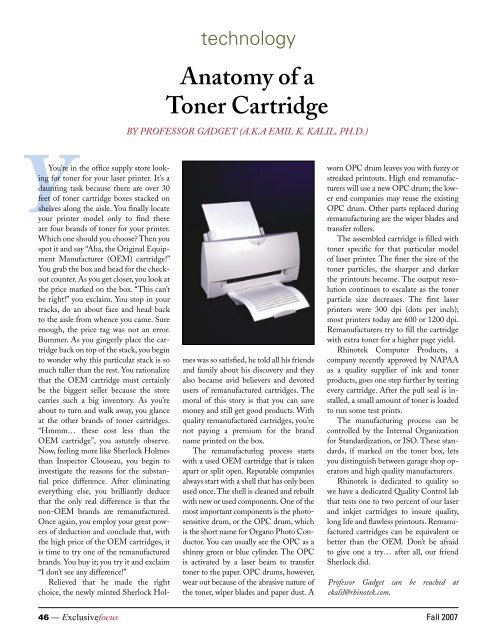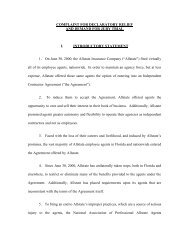EF Fall 07.indd - National Association of Professional Allstate ...
EF Fall 07.indd - National Association of Professional Allstate ...
EF Fall 07.indd - National Association of Professional Allstate ...
You also want an ePaper? Increase the reach of your titles
YUMPU automatically turns print PDFs into web optimized ePapers that Google loves.
technologyAnatomy <strong>of</strong> aToner CartridgeBY PROFESSOR GADGET (A.K.A EMIL K. KALIL, PH.D.)You’re in the <strong>of</strong>fice supply store lookingfor toner for your laser printer. It’s adaunting task because there are over 30feet <strong>of</strong> toner cartridge boxes stacked onshelves along the aisle. You finally locateyour printer model only to find thereare four brands <strong>of</strong> toner for your printer.Which one should you choose? Then youspot it and say “Aha, the Original EquipmentManufacturer (OEM) cartridge!”You grab the box and head for the checkoutcounter. As you get closer, you look atthe price marked on the box. “This can’tbe right!” you exclaim. You stop in yourtracks, do an about face and head backto the aisle from whence you came. Sureenough, the price tag was not an error.Bummer. As you gingerly place the cartridgeback on top <strong>of</strong> the stack, you beginto wonder why this particular stack is somuch taller than the rest. You rationalizethat the OEM cartridge must certainlybe the biggest seller because the storecarries such a big inventory. As you’reabout to turn and walk away, you glanceat the other brands <strong>of</strong> toner cartridges.“Hmmm… these cost less than theOEM cartridge”, you astutely observe.Now, feeling more like Sherlock Holmesthan Inspector Clouseau, you begin toinvestigate the reasons for the substantialprice difference. After eliminatingeverything else, you brilliantly deducethat the only real difference is that thenon-OEM brands are remanufactured.Once again, you employ your great powers<strong>of</strong> deduction and conclude that, withthe high price <strong>of</strong> the OEM cartridges, itis time to try one <strong>of</strong> the remanufacturedbrands. You buy it; you try it and exclaim“I don’t see any difference!”Relieved that he made the rightchoice, the newly minted Sherlock Holmeswas so satisfied, he told all his friendsand family about his discovery and theyalso became avid believers and devotedusers <strong>of</strong> remanufactured cartridges. Themoral <strong>of</strong> this story is that you can savemoney and still get good products. Withquality remanufactured cartridges, you’renot paying a premium for the brandname printed on the box.The remanufacturing process startswith a used OEM cartridge that is takenapart or split open. Reputable companiesalways start with a shell that has only beenused once. The shell is cleaned and rebuiltwith new or used components. One <strong>of</strong> themost important components is the photosensitivedrum, or the OPC drum, whichis the short name for Organo Photo Conductor.You can usually see the OPC as ashinny green or blue cylinder. The OPCis activated by a laser beam to transfertoner to the paper. OPC drums, however,wear out because <strong>of</strong> the abrasive nature <strong>of</strong>the toner, wiper blades and paper dust. Aworn OPC drum leaves you with fuzzy orstreaked printouts. High end remanufacturerswill use a new OPC drum; the lowerend companies may reuse the existingOPC drum. Other parts replaced duringremanufacturing are the wiper blades andtransfer rollers.The assembled cartridge is filled withtoner specific for that particular model<strong>of</strong> laser printer. The finer the size <strong>of</strong> thetoner particles, the sharper and darkerthe printouts become. The output resolutioncontinues to escalate as the tonerparticle size decreases. The first laserprinters were 300 dpi (dots per inch);most printers today are 600 or 1200 dpi.Remanufacturers try to fill the cartridgewith extra toner for a higher page yield.Rhinotek Computer Products, acompany recently approved by NAPAAas a quality supplier <strong>of</strong> ink and tonerproducts, goes one step further by testingevery cartridge. After the pull seal is installed,a small amount <strong>of</strong> toner is loadedto run some test prints.The manufacturing process can becontrolled by the Internal Organizationfor Standardization, or ISO. These standards,if marked on the toner box, letsyou distinguish between garage shop operatorsand high quality manufacturers.Rhinotek is dedicated to quality sowe have a dedicated Quality Control labthat tests one to two percent <strong>of</strong> our laserand inkjet cartridges to insure quality,long life and flawless printouts. Remanufacturedcartridges can be equivalent orbetter than the OEM. Don’t be afraidto give one a try… after all, our friendSherlock did.Pr<strong>of</strong>essor Gadget can be reached atekalil@rhinotek.com.46 — Exclusivefocus <strong>Fall</strong> 2007
















